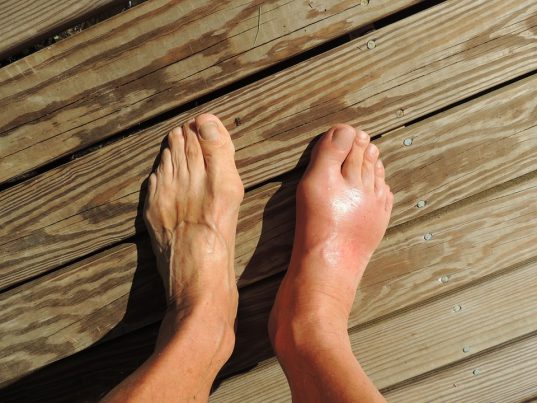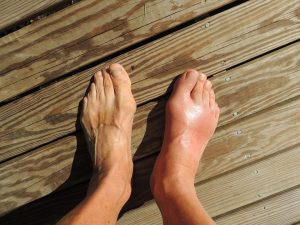
Gout – causes, side effects and treatments at NaturalPedia.com
Friday, April 06, 2018 by Zoey Sky
http://www.naturalpedia.com/gout-causes-side-effects-and-treatments-at-naturalpedia-com.html

Patients with gout, a common type of arthritis, often experience intense pain, stiffness, and swelling in a joint. Gout frequently affects the joint in the big toe.
Gout attacks may come on quickly and they can be intermittent. These attacks gradually cause damage to tissues in the region where the inflammation occurs. Gout attacks are also linked to a higher risk for cardiovascular and metabolic disease, and they can be extremely painful.
Gout is the most common form of inflammatory arthritis in men. However, while gout often affects men, women are more susceptible to it after menopause.
According to the Centers for Disease Control and Prevention (CDC), about 8.3 million Americans developed gout from 2007 to 2008.

Known side effects of gout
The side effects of gout often become symptomatic, and these suddenly occur without warning. The side effects of gout often manifest in the middle of the night.
The main symptoms of gout include:
- Inflammation
- Intense joint pain which subsides to discomfort
- Redness
Gout usually affects the large joint of a patient’s big toe, but it can also affect the ankles, elbows, fingers, knees, and wrists.
Risk factors for gout may include:
- Age and gender — Men produce more uric acid than women. However, women’s levels of uric acid are almost the same as men after menopause.
- Genetics — If you have a family history of gout, your risk of developing gout is higher.
- Lead exposure — Constant exposure to lead is connected to some cases of gout.
- Lifestyle choices — Alcohol consumption interferes with how the body removes uric acid.
Body systems harmed by gout
Gout may cause the following complications:
- Kidney stones — Kidney stones may form if your uric acid levels are very high.
- Permanent joint damage — May occur due to intermittent gout attacks/chronic gout.
- Tophi — Tophi are tiny white lumps of urate crystals that appear under the skin, such as the ears, elbows, or fingers. Tophi can be painful and they can be caused by chronic gout.
Food items or nutrients that may prevent gout
Patients with gout need to know that eating certain foods may trigger an attack. These trigger foods are often rich in purines, a natural substance often found in foods. The purines in trigger foods will raise uric acid levels.
When the body digests purines, uric acid is the resulting waste product. Healthy individuals do not have a problem removing excess uric acid from the body.
Patients with gout are unable to efficiently remove excess uric acid so a diet high in purines can cause uric acid accumulation, which will result in a gout attack.
While a gout-friendly diet eliminates many foods, you can still consume other low-purine foods with less than 100 milligrams (mg) of purines per 3.5 ounces (100 grams [g]).
The following foods or nutrients can help prevent gout:
- Beverages — Coffee, green tea, and tea.
- Dairy products — All dairy is safe to eat, but patients with gout will benefit from low-fat dairy the most.
- Eggs
- Fruits — Most fruits are safe to consume, and cherries can also help prevent attacks by lowering uric acid levels and minimizing inflammation.
- Herbs and spices — All herbs and spices are safe to eat.
- Legumes — All legumes are fine (e.g. beans, lentils, soybeans, and tofu).
- Nuts — All nuts and seeds are safe to eat.
- Plant-based oils — Includes canola, coconut, flax, and olive oil.
- Vegetables — All vegetables are safe to eat, like eggplants, dark green leafy vegetables, mushrooms, peas, and potatoes.
- Whole grains — Includes barley, brown rice, and oats.
Treatments, management plans for gout
Most cases of gout are treated with medication. Medication is often used to treat the symptoms of gout attacks, prevent future flares, and minimize the risk of gout complications (e.g. kidney stones and the formation of tophi).
- Nonsteroidal anti-inflammatory drugs (NSAIDs), colchicine, and corticosteroids — Taken orally, these drugs are used to minimize inflammation and pain in the areas affected by gout.
- Probenecid — Used to improve the kidney’s ability to remove uric acid from the body.
- Xanthine oxidase inhibitors (Allopurinol) — These medications are used to reduce the production of uric acid.
If the patient doesn’t receive immediate treatment, an acute gout attack can worsen at least 12 to 24 hours after it began. Without treatment, a patient will recover after one to two weeks.
Where to learn more
- 5 Gout Pain Relief Natural Remedies That Work
- 5 natural gout home remedies and treatments (prevention)
- Got gout? Get the lead out
- Gout – Seek a drugless approach to this painful condition
- Miracle Cure for Gout and Arthritis Pain? Six Cherries a Day
Summary
Patients with gout, a common type of arthritis, often experience intense pain, stiffness, and swelling in a joint. Gout frequently affects the joint in the big toe.
The side effects of gout often become symptomatic, and these suddenly occur without warning. The side effects of gout often manifest in the middle of the night. The main symptoms of gout include inflammation, intense joint pain which subsides to discomfort, and redness.
Gout can cause complications like kidney stones, permanent joint damage, and tophi.
Eating dairy products, eggs, fruits, herbs and spices, legumes, nuts, plant-based oils, vegetables, and whole grains can help prevent gout.
Treatment for gout includes medications like nonsteroidal anti-inflammatory drugs (NSAIDs), colchicine, corticosteroids, probenecid, and xanthine oxidase inhibitors (Allopurinol).
Sources include
Tagged Under: Tags: gout





